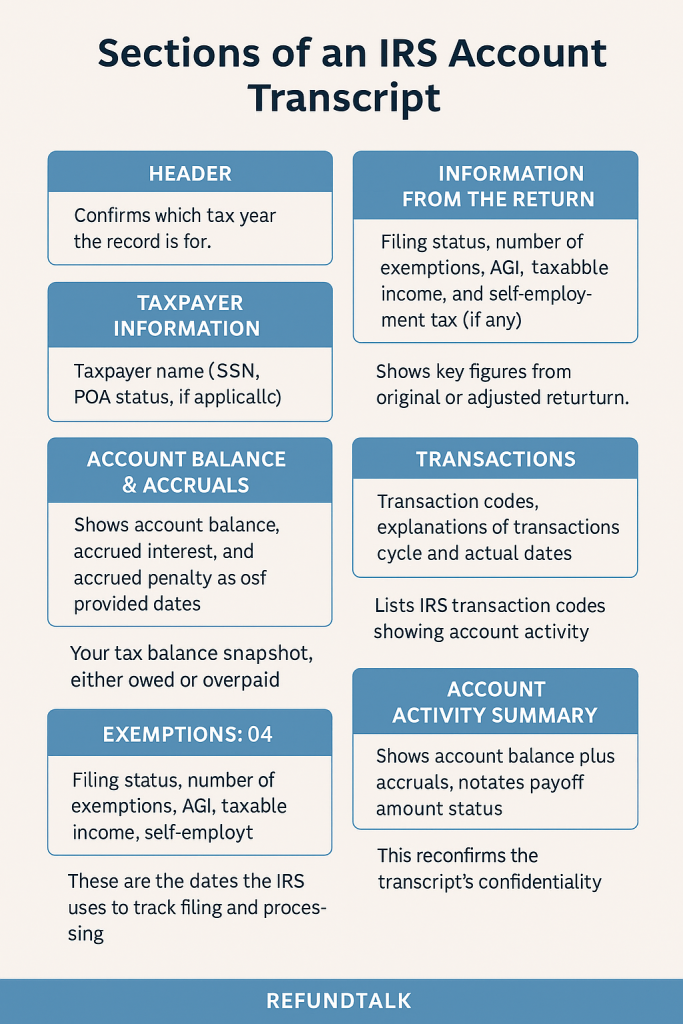
Header Section
What It Includes:
- IRS logo and title: “Account Transcript”
- Request Date and Response Date
- Tracking Number
- Tax Period (e.g., Dec. 31, 2023)
- Form Type (e.g., 1040, 1040A, 1040EZ)
Meaning for Taxpayers:
This confirms which tax year the transcript covers and when it was generated. It’s like the transcript’s “cover page.”
What to Look For:
- Make sure the tax period matches the year you want.
- Note the request and response date—this tells you when the IRS produced the file, which affects how current the data is.
Taxpayer Information Section
What It Includes:
- Taxpayer name(s)
- Taxpayer Identification Number (SSN or ITIN, often masked)
- Spouse’s name and SSN (for joint returns)
- Address (if present)
- Power of Attorney/Tax Information Authorization status (if any)
Meaning for Taxpayers:
This identifies whose account the transcript belongs to and whether someone (like a tax pro or representative) has authorization on file.
What to Look For:
- Confirm the name and masked SSN match your records.
- If you have a representative, ensure it shows as “POA/TIA on file.”
3. Account Balance & Accrual Section
What It Includes:
- Account Balance (total owed or credit)
- Accrued Interest and Accrued Penalty
- Dates “as of” which those amounts were calculated
Meaning for Taxpayers:
This is the IRS’s snapshot of what you owe (or are owed) on the date listed. A minus sign (–) means a credit or refund.
What to Look For:
- “0.00” means the account is fully settled.
- A negative balance (–) indicates a refund or overpayment credit.
- A positive balance means you owe.
- Note “As of Date” — interest and penalties grow from this date forward.
Information From the Return (or As Adjusted)
What It Includes:
- Filing Status (e.g., Married Filing Jointly)
- Number of Exemptions/Dependents
- Adjusted Gross Income (AGI)
- Taxable Income
- Tax Per Return
- Total Self-Employment Tax (if any)
Meaning for Taxpayers:
This section shows the main figures from your filed tax return (or IRS-adjusted amounts if changes were made).
What to Look For:
- Compare AGI and Taxable Income with your filed return to ensure no IRS adjustments.
- Differences may mean an IRS correction, amended return, or math error.
- This section can confirm your income for loans, financial aid, or IRS verification.

Return Due Date / Return Received Date
What It Includes:
- “Return Due Date or Return Received Date (Whichever is Later)”
- “Processing Date”
Meaning for Taxpayers:
These show when your return was due or received and when the IRS started processing it.
What to Look For:
- The received date is key—it shows when your return officially entered the system.
- The processing date helps estimate when updates (like refund release) might occur.
Transaction Section
What It Includes:
A chronological list of IRS Transaction Codes (TCs) showing all actions on your account:
- Code: numeric IRS transaction code (e.g., 150, 846, 570)
- Explanation of Transaction: short description (e.g., “Return filed,” “Refund issued”)
- Cycle Date: IRS posting cycle (e.g., 20241205)
- Date: actual transaction date
- Amount: money associated with that action
Meaning for Taxpayers:
This is the heart of the transcript — it shows the step-by-step history of how the IRS processed your return, refund, and any adjustments.
What to Look For:
- TC 150 → your return was filed and posted
- TC 570 → a hold or pending review (refund frozen)
- TC 571 or 572 → hold released
- TC 846 → refund issued (look for this to confirm your deposit date)
- TC 971 → notice sent
- TC 290/291 → tax increased/decreased
- TC 841 → refund canceled or reversed
These codes help you understand what’s happening and when.
Account Activity Summary (Totals)
What It Includes:
- Account Balance Plus Accruals
- “This is not a payoff amount” disclaimer
Meaning for Taxpayers:
Shows your account’s current balance snapshot, including accrued interest and penalties (if any).
What to Look For:
- If the balance isn’t zero, verify whether the amount is owed or overpaid.
- The “not a payoff amount” line reminds you that interest may continue until paid.
Footer Section
What It Includes:
- Repeated disclaimer: “This Product Contains Sensitive Taxpayer Data”
- Sometimes page numbers or system identifiers
Meaning for Taxpayers:
Just confirms confidentiality and that the document is an official IRS transcript.
What to Look For:
- Nothing actionable — just verify all pages are present if printing or submitting for proof of income.
Quick Tip for Reading Your Tax Account Transcript
| Symbol | Meaning |
|---|---|
| Minus (–) | Credit or refund amount |
| Positive number | Balance due to IRS |
| Cycle Code | IRS posting week and day |
| As of Date | IRS accounting snapshot date |
| TC 846 | Refund issued (refund approved) |
| TC 570 | Refund hold / under review |
